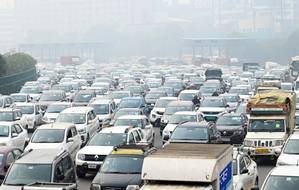NHAI to roll out automatic tolling with high speed cameras on Chennai-Bengaluru, GST roads
By IANS | Updated: November 6, 2025 12:30 IST2025-11-06T12:29:43+5:302025-11-06T12:30:09+5:30
Chennai, Nov 6 In a major infrastructure upgrade aimed at eliminating traffic snarls at toll plazas, the National ...

NHAI to roll out automatic tolling with high speed cameras on Chennai-Bengaluru, GST roads
Chennai, Nov 6 In a major infrastructure upgrade aimed at eliminating traffic snarls at toll plazas, the National Highways Authority of India (NHAI) is set to introduce a camera-based automatic toll collection system on key stretches of the Chennai-Bengaluru National Highway and GST Road.
The initiative will replace conventional toll booths with Automatic Number Plate Recognition (ANPR) cameras integrated with the FASTag platform, enabling vehicles to pass through toll points without stopping.
The system, known as Multi-Lane Free Flow (MLFF), is designed to capture vehicle registration details at speeds of up to 150 kmph, ensuring seamless, congestion-free travel.
The new system will first be implemented at the Nemili (Sriperumbudur) and Chennasamudram toll plazas on the Chennai-Bengaluru NH, and at Paranur toll plaza on the Tambaram-Villupuram stretch of GST Road.
Together, these busy corridors handle around 75,000 passenger car units daily, according to NHAI data.
Once operational, the ANPR cameras will automatically record vehicle details and deduct the applicable toll amount from the driver’s FASTag account.
The move is expected to drastically reduce travel time and fuel wastage while improving traffic flow across major intercity routes.
The Indian Highways Management Company Limited (IHMCL) under the Union Ministry of Road Transport and Highways, will oversee the implementation.
It has already floated tenders to select an operator for designing, developing, and maintaining the system for a five-year term.
Officials said the six-lane main carriageway will remain fully open to traffic, with overhead ANPR cameras and RFID readers placed strategically for smooth toll deduction.
“The system involves installation of complex equipment and will undergo multi-level verification before being commissioned,” an official said.
Each camera will be capable of capturing clear images of number plates and short video clips from a distance of up to 40 metres, with additional RFID devices identifying vehicles as far as 300 metres before they reach the toll point.
The contractor will be required to complete installation within 14 months of the work order. Separate procedures will be notified later to handle toll recovery from vehicles where automatic deduction fails, officials added.
Once fully operational, the MLFF system is expected to make long queues at toll plazas a thing of the past, ushering in a new era of smart, fast, and frictionless highway travel.
Disclaimer: This post has been auto-published from an agency feed without any modifications to the text and has not been reviewed by an editor
Open in app